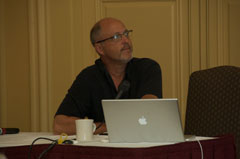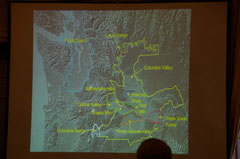Terroirs of the Walla Walla Valley with Dr. Kevin Pogue
By Kori ~ August 9th, 2010.
 At the recent Wine Bloggers Conference in Walla Walla, Washington, one of the most interesting and informative sessions of the weekend was the Terroirs of the Walla Walla Valley seminar with Dr. Kevin Pogue, chair of the Geology Department at Whitman College in Walla Walla. Dr. Pogue has conducted research and led field trips in the Pacific Northwest for more than 25 years. His research interests have included the deposits of the Ice Age Missoula floods that form the basis for the soils of many of eastern Washington’s premier vineyards. He is currently involved in research on the geologic and geographic controls on the terroir of the Walla Walla Valley American Viticulture Area. He began focusing his research in this area after people in the wine industry in Walla Walla started asking him questions about where the right dirt for growing wine grapes would be. He soon realized that most people weren’t really thinking about the right places to plant vineyards in the Valley, and he thought he could help them.
At the recent Wine Bloggers Conference in Walla Walla, Washington, one of the most interesting and informative sessions of the weekend was the Terroirs of the Walla Walla Valley seminar with Dr. Kevin Pogue, chair of the Geology Department at Whitman College in Walla Walla. Dr. Pogue has conducted research and led field trips in the Pacific Northwest for more than 25 years. His research interests have included the deposits of the Ice Age Missoula floods that form the basis for the soils of many of eastern Washington’s premier vineyards. He is currently involved in research on the geologic and geographic controls on the terroir of the Walla Walla Valley American Viticulture Area. He began focusing his research in this area after people in the wine industry in Walla Walla started asking him questions about where the right dirt for growing wine grapes would be. He soon realized that most people weren’t really thinking about the right places to plant vineyards in the Valley, and he thought he could help them.
The following are highlights from his seminar that I think my fellow wine geeks will find interesting. However, if you have no interest in learning about where your wine comes from, then you should probably skip the rest of this post.
“Now, I’m a 100% ‘terroir-ist’.†–Dr. Kevin Pogue
People generally only talk about terroir on the vineyard scale but don’t really talk about the terroir of a whole AVA (American Viticultural Area). Dr. Pogue talked about “terroirs†plural. Terroir is a difficult thing to define. Terroir is the fact that you can tell that a wine came from a unique place and something about that place is expressed in the wine. There are two types of terroir: cultural and physical. Dr. Pogue’s specialty is the physical terroir and all of those things affect grape varieties.
“Terroir does matter. Grapes don’t get ripe in some places, and they get ripe in other places. Soils have different drainage characteristics and different chemistries. It matters, and you can taste it.†–Dr. Kevin Pogue
In physical terroir, you have soils, geography, and climate. You can’t talk about Walla Walla as having one soil, one geography, and one climate because it is a large area and those things have a lot of variability. There are actually several macro-terroirs in the Valley.
The 46° North latitude line runs right through the Walla Walla Valley AVA. Looking at that latitude around the globe, it puts Walla Walla in really good company, between Bordeaux and Burgundy, and halfway between the Rhone and Burgundy. Walla Walla is on the boundary between the Columbia Basin and the Blue Mountains. The Cascade Mountains shield Walla Walla from the wet, foggy weather that is common on the west side of the state.
The bedrock in the Walla Walla Valley is Columbia River basalt. It is one of the largest areas of basalt bedrock on the continents anywhere in the world. The ocean basins are 100 percent basalt, but it is a relatively rare rock type up on the continent. Basalt is a dense, heavy rock and so much of it was erupted that it depressed the surface of the earth.
“So we actually owe the fact that we have a low elevation here that is warm enough and suitable for viticulture to the fact that the weight of the erupted basalt depressed the elevations in this area.†–Dr. Kevin Pogue
Overlying the basalt and below 1200 feet elevation, the Touchet beds are found. They are flood sediments from some catastrophic glacial floods. Then, there is the Palouse formation which is loess, a geologic term for wind-blown silt, that drapes everything. And then carved into that are stream deposits.
Ice Age Missoula Floods
The Ice Age floods are the largest documented floods in earth history. Ice came down into the Northwest. Puget Sound was essentially carved by ice. Seattle was under thousands of feet of ice. Ice came down into the Idaho panhandle and down the Clark Fork River and created a huge lake called Glacial Lake Missoula that was as big as two of the present-day Great Lakes. Missoula, Montana was under 600 feet of water. When the water got high enough, it floated the ice and all of the water spilled out catastrophically. The rushing water across the Columbia Basin was ten times the combined flow of all the world’s rivers. It had a profound effect on the topography and geology of eastern Washington and flooded the Willamette Valley. All of the water fit through a narrow passage called the Wallula Gap, which is about 30 miles west of Walla Walla. Most of the Columbia Valley AVA was affected by these floods.
While the water was temporarily impounded at that constriction at Wallula Gap, it created a lake and when the water stagnated, it dropped its load of sediment. It flooded the Walla Walla Valley and the Yakima Valley and everything up to about 1,200 feet. Some of the vineyards in the Walla Walla Valley are above that flood line and some are below, so they have different sediments depending on where they are relative to that flood line.
Many of the vines in the Walla Walla Valley are rooted in those sediments. They are sandy and contain exotic rocks. These sediments weren’t derived from basalt. They came from the Idaho panhandle, Montana, and northeast Washington where the bedrock is granite. The chemistry of the sediments is completely different from the underlying bedrock. Most places you go, the sediments are made of the decomposed bedrock that is underneath them. All of the sediments in the Walla Walla Valley are exotic. They were washed in or blown in from somewhere else and their chemistry is completely different. If you get a vine that roots through these into the basalt, it suddenly encounters a completely different suite of elements and minerals.
 Dust Storms
Dust Storms
The Walla Walla Valley usually has two or three huge dust storms in October. After each flood, there was this barren landscape of flood plains. The winds would blow across that, pick up the dust clouds, and blow them across eastern Washington. It is still blowing around and gets deposited in the Palouse hills.
Blue Mountains
The next thing that happened is that the Walla Walla Valley had uplift of the Blue Mountains. The streams responded to that by down-cutting and cutting canyons. Channels come out into the Valley and those channels are trying to wash out those Missoula flood sediments and replace them with gravel derived from the Blue Mountains. Where streams were, they leave behind deposits of gravel. If you dig a hole in downtown Walla Walla, it’s nothing but stream gravels.
Soils present in the Walla Walla Valley
- Loess – Wind-deposited silt, almost everywhere in the Walla Walla Valley has that at least in the upper two or three feet
- Missoula flood deposits – Huge floods between 12,000 to 15,000 years ago.
- Basalt – Pebbles, cobbles, some basalt bedrock
- Caliche – Calcium carbonate deposits that occurs in semi-arid regions
- Volcanic ash
- Ice grafted erratic rocks – Don’t affect terroir at all
Four terroirs of the Walla Walla Valley
- Thick, thick, thick, deep loess. Where the vines never see anything but loess, wind-deposited silt. Thick loess with calcareous horizons can be found in the Loess Hills that are to the northeast of town or in the Blue Mountain foothills. (Vineyards with this terroir: Spring Valley, Leonetti Upland, Leonetti Loess, Dwelley, Les Collines)
- Silt on top of Missoula flood sediments. Probably the most planted type of terroir in the Walla Walla Valley. Found in the valley floor below 1,200 feet elevation. (Vineyards with this terroir: Pepper Bridge, Seven Hills, Forgotten Hills)
- Stream gravels. Only occur in alluvial fans. The town of Walla Walla has obliterated most of the Walla Walla alluvial fan. There are a few vineyards in the Mill Creek fan up by K Vintners but all of downtown Walla Walla would be a really great gravelly terroir, but buildings and streets occupy it. The alluvial fan in Milton-Freewater, Oregon, just south of Walla Walla, has historically been an orchard area and preserved from development. It is almost entirely basalt cobbles. It is very rocky and looks like Chateauneuf-du-Pape. (Vineyards with this terroir: Cayuse)
- Basalt. Thin loess over basalt bedrock. Above 1,200 feet or in places steep enough that most of sediment has been washed away. This is a new terroir.
There is great potential to exploit even more terroirs in the Walla Walla Valley, like up in the Blue Mountains.
Climate
Because the Walla Walla Valley is further north than Napa, it has more hours of sunlight. In addition, the sun angle is lower. Some say that Walla Walla has longer, gentler sun each day. On average, Walla Walla has 30 to 40 more minutes of sunlight each day in the summer. It is a little warmer than Napa, warmer than Bordeaux, cooler than southern Rhone, and a lot warmer than Burgundy or the Willamette Valley. Walla Walla gets huge diurnal temperature variation. It is really dry. Most of the Columbia Basin has less than 10 inches of annual precipitation so irrigation is an absolute necessity. Walla Walla gets a little more rainfall due to its proximity to the Blue Mountains.
Summary: Characteristics of the physical terroir of the Walla Walla Valley AVA
- Combination of low rainfall and well-drained soils allows precise control of water.
- High latitude provides long summer days and not-too-hot falls with balanced ripening.
- Low humidity and clear skies lead to cool nights and high diurnal temperature variation, which preserves acidity, promotes balanced ripening.
- Variations in soil types, elevation, and climate characteristics permit wide range of cultivars.
If you want to learn more about the terroirs of the Walla Walla Valley, check out Dr. Pogue’s essay on the relationship of the Missoula floods to Columbia Basin viticulture in the book, Washington: The State of Wine, or visit his webpage for contact information and a list of his publications.
Filed under: American Wine, Vineyards, Washington State Wine

 Wine Peeps is an independent wine blog dedicated to helping you get the most bang for your buck in wine. We do this through blind tastings of wine from around the world and calculations of
Wine Peeps is an independent wine blog dedicated to helping you get the most bang for your buck in wine. We do this through blind tastings of wine from around the world and calculations of 











Interesting research on how water and sediment come into play.
http://www.blog.onxwine.com
Fascinating! I could listen to Dr. Pogue over and over again. In fact, I finally had an opportunity to go out in the field with him and see first hand about the terroirs of Walla Walla. I’ll post about it later.